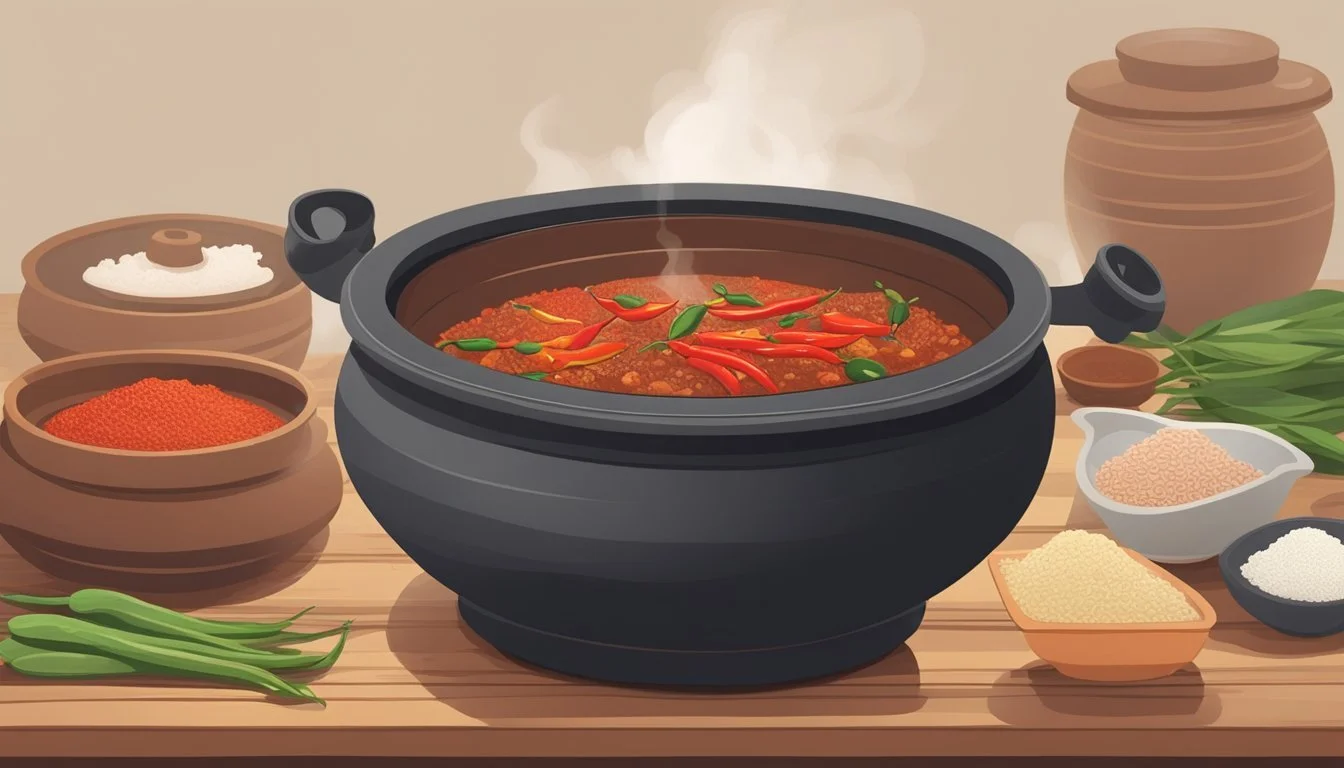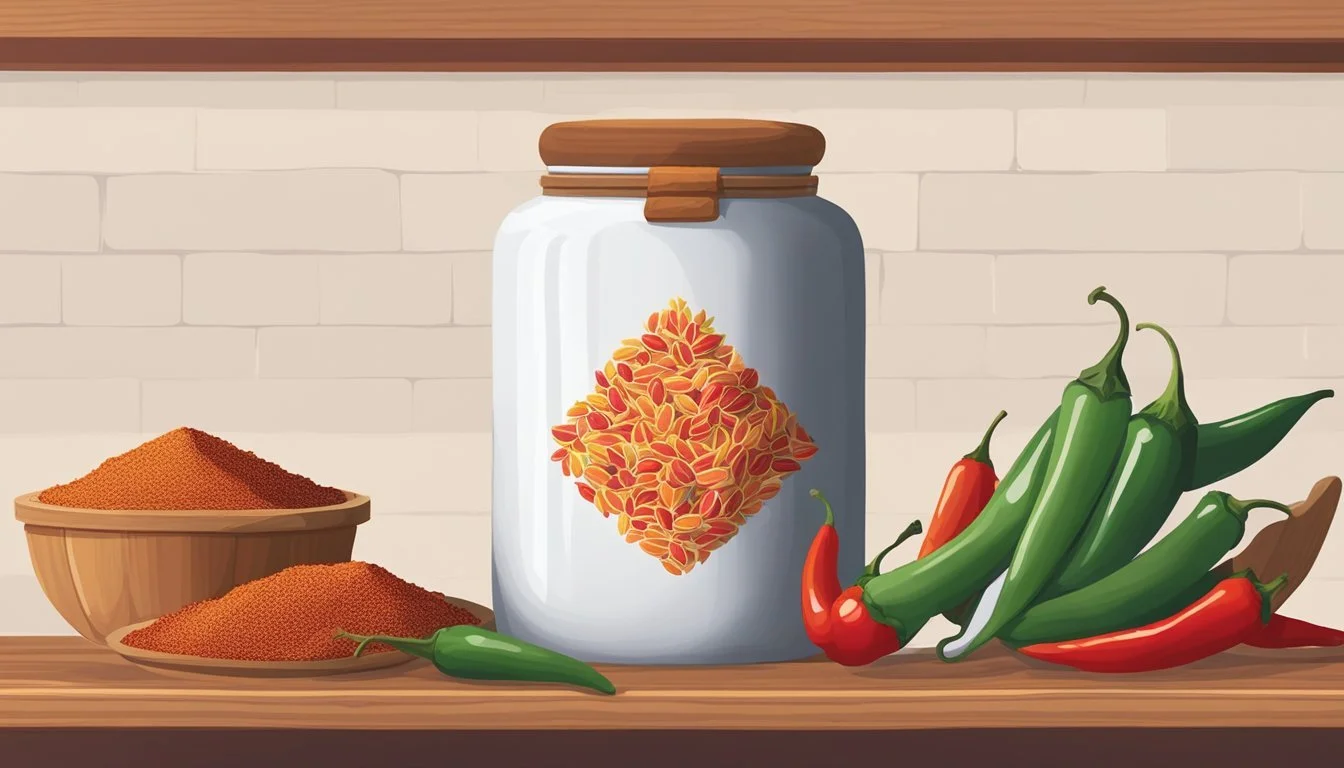How to Ferment Gochujang
Mastering Korean Red Chili Paste Fermentation
Gochujang is a quintessential Korean condiment with a history that runs deep in the country's culinary practices. It is a fermented red chili paste that melds complex layers of heat, sweetness, and umami, making it an indispensable ingredient in Korean cuisine. The traditional process of fermenting gochujang involves a thoughtful blend of glutinous rice, red chili powder, fermented soybeans, and salt. This combination, underpinned by the subtle art of fermentation, imparts a distinctive, robust flavor and a versatile potency that enhances the taste of numerous Korean dishes.
The art of fermenting gochujang is as much about patience as it is about technique. The ingredients are intricately proportioned and mixed before they undergo a natural fermentation process, often in large earthenware called jangdokdae. These vessels are then placed outdoors, allowing the mixture to ferment gradually, often over the course of several months to years, depending on the desired intensity of flavor. This meticulous process allows natural microbes to work their magic, breaking down the starches and proteins to develop a rich and complex taste profile.
In contemporary preparations, variations exist in the fermentation duration and types of containers used, yielding different flavor nuances and texture. Regardless of the method, gochujang remains a revered staple in Korean cooking, capable of elevating a simple dish to something remarkable with its deep, vibrant flavors. Its application is versatile, featuring in marinades, soups, stews, and dipping sauces, underscoring its pivotal role in the tapestry of Korean gastronomy.
History and Cultural Significance
Gochujang's rich legacy is intertwined with traditional Korean culinary practices, embodying both ancient technique and cultural expression. This fermented condiment is a staple in authentic Korean cuisine.
Origins of Gochujang
The development of gochujang dates back to the Goryeo Dynasty, between the 10th and 14th centuries. It is believed that the methods for creating this paste were influenced by other ancient Asian fermentation techniques. Originally, gochujang was a way to preserve and enhance flavor, utilizing the natural processes of fermentation.
Key components in traditional gochujang include:
Gochu-garu: Red chili powder
Glutinous rice: Adds sweetness and aids fermentation
Meju: Fermented soybean powder
Yeotgireum: Barley malt powder
Salt: Preservative that aids in fermentation
Gochujang in Korean Cooking
In Korean cooking, gochujang is more than just a food item; it is a foundational element that imparts depth and complexity to dishes. Its unique blend of sweetness, spiciness, and umami elevates the flavors of various Korean food (What wine goes well with Korean food?) such as bibimbap, tteokbokki, and marinades for meats. The fermentation process, which can take several months to years, ensures that gochujang develops a rich flavor profile that is both distinctive and integral to Korean cuisine.
Essential Ingredients and Substitutes
In the process of fermenting gochujang, the selection of ingredients and their substitutes plays a crucial role. The right blend and balance ensure the traditional flavor, while alternatives can tailor the paste to dietary needs and availability.
Gochugaru: The Core of Spiciness
Gochugaru, or Korean red chili powder, is indispensable for its vibrant heat and color. It's made from sun-dried chilies and imparts a distinct flavor that is essential to gochujang. An acceptable substitute is gochugaru flakes; however, the texture might slightly differ due to the flake size. Other chili powders can be used in a pinch but will alter the taste profile.
Sweet Rice Flour and Its Alternatives
Sweet rice flour, derived from glutinous rice, thickens the paste and gives gochujang its characteristic sticky texture. An alternative is regular rice flour, although it may not provide the same chewiness. In absence of rice flours, cornstarch can be a last resort, but it lacks the sweet undertone.
The Role of Fermented Soybeans
Fermented soy products like fermented soybean powder or fermented soybeans (meju) form the base umami backbone of gochujang. These can be homemade or store-bought. If these products are difficult to find, miso paste, a Japanese fermented soybean paste, serves as the next closest option in flavor and texture.
Sweetening Agents: From Traditional Jocheong to Modern Sugar
Traditional gochujang recipes use jocheong (rice syrup) for sweetness and richness. An alternative sweetener is sugar, which can easily adjust the sweetness level, but with a simpler taste profile. Another modern substitute is corn syrup, providing a similar texture to rice syrup.
Finding the Right Salt and Its Substitutes
Sea salt is favored in gochujang for its natural minerals and taste, complementing the fermenting process. It should be used judiciously to avoid overpowering other ingredients. If sea salt is unavailable, kosher salt is a decent substitute, though it's less mineral-rich. Avoid iodized table salt, which can negatively affect fermentation and taste.
Traditional Preparation Methods
In the traditional preparation of Gochujang, meticulous attention to cleanliness and methodical ingredient handling are paramount to achieve the desired fermentation and flavor. These processes leverage the natural environment and time-tested techniques.
The Importance of Sterilization
Prior to mixing the ingredients, sterilizing the earthenware is critical to prevent unwanted bacteria from spoiling the Gochujang. Traditional methods include pouring boiling water within the vessel and leaving it to dry under the sun. This ensures a clean environment for fermentation.
Preparation of Ingredients
Ingredients must be carefully selected and prepared before fermentation:
Chili peppers: Ground into a fine powder.
Glutinous rice: Cooked and pounded into a paste.
Fermented soybeans: Often used in powdered form.
Salt: Crucial for taste and preservation.
The preparation often involves soaking grains like sweet rice in water for several hours to soften them.
Mixing and Fermentation Process
After ingredient preparation, the creation of Gochujang follows these steps:
Mixing ingredients: Combining chili pepper powder, glutinous rice paste, fermented soybean powder, and salt.
Filling earthenware: The mixture is transferred into the sterilized earthenware.
Temperature and exposure: The vessel is covered loosely and placed in a location that receives constant sunlight, which aids the fermentation process.
Maintenance: Temperature should be monitored, and the vessel brought indoors in inclement weather to maintain a consistent fermentation environment over several months.
Modern Homemade Gochujang Techniques
Creating homemade gochujang has evolved with today's kitchen conveniences, allowing for easier preparation and customization of flavor and texture to personal tastes.
Adapting Traditional Recipes for Today
Traditional gochujang recipes have been modernized to suit the convenience and speed of contemporary cooking. Individuals can adjust the levels of spiciness and sweetness by varying the amounts of gochugaru (Korean chili powder) and sweeteners like honey or rice syrup. In doing so, they can tailor the gochujang to their preferred flavor profile while respecting the essence of the historical recipe.
Utilizing Kitchen Equipment
Modern kitchen equipment greatly simplifies the making of homemade gochujang. A blender can be employed to swiftly mix ingredients into a smooth paste, effectively reducing the laborious process of manual grinding. To achieve the desired texture, one may also use a sieve to strain the mixture, ensuring that the final product is free of lumps and has a uniform consistency.
Blender Use:
Combine dry and liquid ingredients
Blend until smooth
Sieve Process:
Strain mixture for desired texture
Remove any remaining lumps
Adjusting Flavor and Texture
The flavor and texture of gochujang are paramount and can be adjusted during the fermentation process. For a smoother texture, the mixture should be consistently stirred and checked for consistency. If the gochujang is too thick, a bit of water can be added; if too thin, additional rice flour may help. Fermentation itself is a key flavor enhancer, and the sauce's environment—ideally a warm, sunny spot—plays a crucial role in developing its deep, complex profile. Homemade gochujang makers can experiment with the length of fermentation to alter the flavor intensity.
Cooking and Serving Suggestions
Gochujang, a versatile Korean red chili paste, adds depth and complexity to various dishes. From adding a kick to soups and stews to enhancing marinades, its uses are varied and impactful. This section explores three prime ways gochujang can elevate your cooking.
Incorporating Gochujang in Soups and Stews
Adding gochujang to soups and stews can transform simple dishes into rich, umami-packed meals. For soups, a tablespoon of gochujang can be stirred into broths to infuse them with a warm, spicy flavor. Consider using it in Korean dishes such as Kimchi Jjigae, where its pungency complements the fermented kimchi. In stews, one can blend gochujang into the base to enrich the dish's character. The traditional Korean stew, Doenjang Jjigae, benefits from the red chili paste's robustness, balancing well with the fermented soybean paste already present in the recipe.
Using Gochujang as a Marinade
Gochujang serves as a superb base for marinades. It penetrates proteins with its spicy and slightly sweet notes. For a classic Korean chicken bulgogi, one might combine gochujang with soy sauce, sesame oil, and garlic, coating the chicken thoroughly and letting it marinate for at least an hour. This will produce a succulent dish with a beautiful balance of flavors once cooked.
Variations for Dips and Sauces
Gochujang's adaptability shines in dips and sauces. As a dipping sauce, it can simply be mixed with vinegar and a touch of honey to create a sweet and tangy condiment ideal for snacks like tteokbokki. To make a complex sauce for bibimbap, blend gochujang with sesame oil, sugar, and a bit of water, adjusting to preferred consistency and taste. It can also add a distinct zing to mayonnaise or yogurt, making for dynamic, flavored spreads that are perfect for wraps and sandwiches.
Storage and Preservation
Proper storage and preservation methods are critical for maintaining the quality and longevity of Gochujang. Both store-bought and homemade varieties require careful handling to ensure the paste remains flavorful and free from spoilage.
Proper Refrigeration Techniques
Once opened or prepared, Gochujang should be stored in the refrigerator to prevent spoilage and maintain its quality. The container must be sealed tightly to prevent the paste from drying out and to keep unwanted odors at bay. For homemade Gochujang, one should ensure it’s placed in a sterile, airtight container before refrigeration. To effectively organize Gochujang storage, consider the following points:
Temperature: Keep at a consistent cold temperature.
Container: Use a clean, airtight container.
Location: Store in a cool, dark section of the refrigerator.
Extending Shelf Life
To extend the shelf life of Gochujang and preserve its optimal flavor and texture, some additional steps and considerations are necessary. Here are specific strategies that can help:
For store-bought Gochujang: Always reseal the original packaging if possible, or transfer to an airtight container after opening.
For homemade Gochujang:
Sterilization: Utilize sterile equipment and containers to prevent bacterial growth.
Preservatives: Natural preservatives like salt can help prolong freshness.
By adhering to these storage and preservation techniques, one can ensure that their Gochujang remains of the highest quality for as long as possible.
Health Benefits and Dietary Considerations
Gochujang offers a unique combination of flavors and health benefits, making it more than just a spicy addition to meals. Its fermentation process introduces beneficial enzymes, while considering dietary restrictions remains straightforward with gluten-free and vegan options available.
Nutritional Aspects of Gochujang
Fermented foods (What wine goes well with fermented foods?) like Gochujang are known for their enzyme content which can aid in digestion and nutrient absorption. Gochujang contains vitamins such as Vitamin C, important for immune system health and iron absorption, and B vitamins including thiamin, riboflavin, and pyridoxine. Additionally, the umami flavor of Gochujang, derived from fermented soybeans, not only enhances taste but also contributes to its nutritional profile.
Vitamin C: Aids in the growth, development, and repair of all body tissues
B Vitamins: Play a role in brain function and energy levels
Gluten-free and Vegan Options
Gochujang traditionally contains glutinous rice, which is naturally gluten-free. However, individuals with gluten sensitivities should verify the ingredients, as some commercial varieties may include additives containing gluten. For vegan diets, the primary consideration is ensuring that no fish or seafood-based products have been added. Many commercially available Gochujang brands provide clear labeling to assist with dietary requirements.
Troubleshooting and Common Mistakes
Perfecting Gochujang at home can be a satisfying culinary adventure, but it's essential to recognize and rectify common missteps to achieve the best flavor and proper fermentation.
Balancing Flavor Profiles
When crafting Gochujang, one must carefully balance the spicy, sweet, and umami elements. Each ingredient contributes to this balance:
Spicy: Predominantly comes from the red chili powder. Too much can overpower the other flavors; too little can make the Gochujang taste bland.
Sweet: Derived from ingredients like rice syrup. An overabundance can suppress the paste's signature kick, whereas insufficient sweetness can result in an excessively harsh taste.
Salty: The necessary salt can vary. If the Gochujang tastes overly salty, it may struggle to incorporate other flavors harmoniously. Conversely, not enough salt can lead to inadequate fermentation.
Adjustments should be made carefully and incrementally to prevent overcorrection.
Dealing with Fermentation Issues
During fermentation, several issues can arise:
Temperature: Gochujang requires warm conditions. Too cold, and fermentation slows; too hot, and it may spoil.
Environment: A dry, shaded area is ideal. Excess moisture can result in unwanted mold, while direct sunlight can cause overheating.
Time: Rushing the process can lead to underdeveloped flavors. Fermentation can take several months to over a year, depending on conditions and desired flavor intensity.
Observing changes in texture, smell, and taste over time can provide clues to the health of the fermentation process. If mold appears, one should remove it promptly to prevent it from spreading.
Online Resources and Community Engagement
Fermenting Gochujang is a process enriched by a vibrant online community and an array of digital resources. Enthusiasts can connect with experts, share their fermentation journeys, and stay updated on the latest tips and techniques through social media platforms and specialized content delivered directly to their inboxes.
Social Media Tips
Instagram has become a treasure trove for Gochujang enthusiasts. With its visually driven platform, users can find numerous accounts dedicated to Korean cooking where tips on fermentation are frequently shared. They can follow renowned chefs and home cooks who often post detailed recipes and step-by-step videos that can be especially helpful. Users may search for hashtags like #GochujangMaking or #FermentedFoods for targeted advice and inspiration.
To Connect with the Community:
Follow accounts that focus on Korean cuisine.
Engage with posts by liking, commenting, and asking questions.
Share personal Gochujang fermentation experiences to exchange knowledge.
Email Newsletters and Blogs
For those who prefer a more in-depth look at Gochujang fermentation, email newsletters from expert food bloggers provide valuable insights. By subscribing, individuals can receive updates about fermentation techniques, hear about the latest trends, and learn about new products. For instance, bloggers might review different types of earthenware pots available on platforms like Amazon, noting which are best for Gochujang fermentation.
Recommended Actions:
Subscribe to newsletters from reputable Korean cooking blogs.
Check for product recommendations, such as fermentation jars on Amazon.
Read blogs for detailed guides and personal fermentation stories.
Conclusion
Fermenting Gochujang requires time and attention to detail. The process calls for patience as the mixture undergoes its transformation, generally over the span of several months to years. The fermenter must trust in the natural progression, allowing the paste to develop its distinct deep flavors and rich texture.
They should possess confidence in their skills, knowledge, and the traditional methods employed. Ensuring the ideal conditions for fermentation – such as using an earthenware pot for breathability or a glass jar with cheesecloth, and monitoring the environment for temperature changes – are critical steps that must be taken with care.
The fermenter's commitment is rewarded with a unique homemade Gochujang that boasts a complex profile, enhancing a variety of dishes with its umami-rich, pungent, and versatile character. This homemade condiment is both a testament to the fermenter's skill and a tribute to the rich culinary heritage of Korea.
Remember, achieving the desired flavor balance between the glutinous rice, fermented soybeans, red chili, and salt, is not just a matter of following a recipe; it's an art that is perfected over time. Homemade Gochujang brings a touch of authenticity to every meal, affirming a connection to traditional Korean gastronomy.
Additional Resources
For enthusiasts looking to deepen their understanding and skills in fermenting Gochujang, there are several resources available. These resources expand on the craft of making Gochujang, providing both historical context and modern techniques.
Books and Documentaries
Books:
The Art of Fermentation by Sandor Katz includes a comprehensive look at fermentation traditions across the world, including a section on making traditional Korean condiments like Gochujang.
Korean Food Made Simple by Judy Joo offers recipes and tips for Korean cooking, along with insights into how Gochujang can be incorporated in various dishes.
Documentaries:
Fermented is a documentary that explores the human connection to fermented foods, featuring renowned chefs and food scientists discussing fermentation processes, with segments dedicated to Korean cuisine.
Online Courses and Workshops
Courses:
Websites like Udemy or Skillshare often feature courses on fermentation, Korean cooking, and sometimes specific classes on making Gochujang, taught by experienced chefs and culinary instructors.
Workshops:
Culinary schools or Korean cultural centers sometimes offer hands-on workshops for making Gochujang, where participants can learn and practice under the guidance of an expert.






